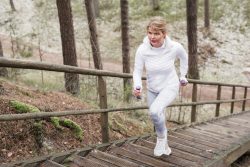 With aging, there’s a noticeable reduction in both the frequency and vigor of physical activities, contributing to deteriorating bone health. New research underscores the significance of both organized exercises and routine daily movements in preserving bone integrity. The evidence points to the advantages of integrating activities that exert stress on bones, like fast-paced walking or ascending stairs, into daily habits, underscoring their effectiveness in bone health maintenance.
With aging, there’s a noticeable reduction in both the frequency and vigor of physical activities, contributing to deteriorating bone health. New research underscores the significance of both organized exercises and routine daily movements in preserving bone integrity. The evidence points to the advantages of integrating activities that exert stress on bones, like fast-paced walking or ascending stairs, into daily habits, underscoring their effectiveness in bone health maintenance.
Research discovered that participation in an exercise program over the course of a year enables elderly individuals (ages 70-85) to preserve or even marginally enhance the structural characteristics of their femoral neck, even amidst a decline in bone mineral density.
The subjects, who had not been active physically before, participated in a comprehensive exercise training program. Additionally, half of the participants were involved in a computer-based training program aimed at improving their information processing abilities. Physical activity levels, including the amount and intensity, were monitored using accelerometers before and after a six-month period of training. To evaluate changes in the femoral neck’s bone density and structural characteristics, dual-energy X-ray absorptiometry (DXA) scans were conducted both at the start and conclusion of the year-long exercise program.
Notably, participants who incorporated higher levels of moderate and intense activities into their regimen showed a slower reduction in bone density compared to those who engaged in activities of lower intensity or frequency.
The evidence strongly supports the integration of bone-strengthening activities, such as brisk walking and stair climbing, into daily routines as a means to counteract bone density loss. These findings advocate for a proactive approach to bone health through physical activity, underscoring its importance in the maintenance of skeletal integrity as we age.
To view the original scientific study click below:
Changes in femoral neck bone mineral density and structural strength during a 12-month multicomponent exercise intervention among older adults – Does accelerometer-measured physical activity matter?





